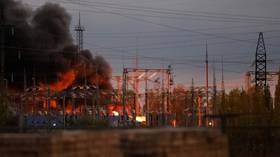Arctic ice pack the size of Florida melted after ‘extreme cyclone’ (VIDEO)

Swirling hot winds caused large chunks of Arctic Ocean ice to melt last year, meaning water usually holed up as ice in glaciers unexpectedly flowed into the sea.
Data obtained by NASA’s climate monitor, the Atmospheric Infrared Sounder, has revealed how a cyclone carrying warm air from the North Atlantic swept across parts of the polar region in December 2015.
And Ice pack the size of Florida disappeared from around the Barents and Kara Seas off Russia in just 10 days, according to the space agency, as the extremely humid air brought temperatures 10 degrees Celsius (50 Fahrenheit) higher than normal.
NASA’s revelation about the melted ice pack came on Monday, the same day United Nations climate change officials released numbers indicating 2016 will be the hottest on record.

Atmospheric measurements recorded onboard the NASA’s Aqua satellite found that the “extreme” cyclone thinned ice by four inches from December 27 to January 5.
The unseasonably warm storm occurred at a time of the year when ice in the region typically builds up rather than melts.
“As a result of this cyclone, the concentration of the sea ice in the Barents and Kara Seas decreased by 10 percent and the sea ice edge moved northward,” said Linette Boisvert, author of the NASA atmospheric study.
READ MORE: ‘Tremendous loss’: Arctic Sea ice shrinks to 2nd lowest level ever
The disruption coincided with some of the lowest levels of ice ever documented by the Aqua satellite.
“In our study, we found that the thinnest ice was completely melted out by the storm. Maybe in the coming years, if we start with a thinner winter ice pack we’ll see extreme events like these cause even bigger melt-outs across the Arctic,” said Alek Petty, of NASA’s Goddard Space Flight Center.
The tail end of 2015 meant bad news for the world’s ice caps, and 2016 is unlikely to be much better. The UN’s World Meteorological Organization suspect the past 12 months will be the hottest ever recorded.
“Another year. Another record. The high temperature we saw in 2015 are set to be beaten in 2016,” said WMO Secretary General Petteri Taalas in a statement.
READ MORE: Watch 30yrs of Arctic ice shrinkage in chilling NASA timelapse (VIDEO)
“In parts of Arctic Russia, temperatures were 6 degrees Celsius to 7 degrees Celsius above the long-term average. Many other Arctic and sub-Arctic regions in Russia, Alaska and northwest Canada were at least 3 degrees Celsius above average.”
Echoing NASA’s statement on the possibility of more natural disasters, Taalas added: “‘Once in a generation’ heatwaves and flooding are becoming more regular. Sea level rise has increased exposure to storm surges associated with tropical cyclones.”
The preliminary report blames the powerful El Nino for a spike temperatures at the start of the year and says sea levels have jumped from the previous annual rise of 3.5mm (0.14 inches) to 15mm in the 18 months up to February.













